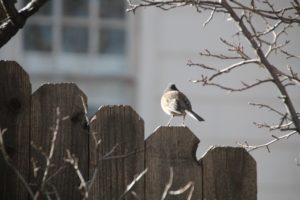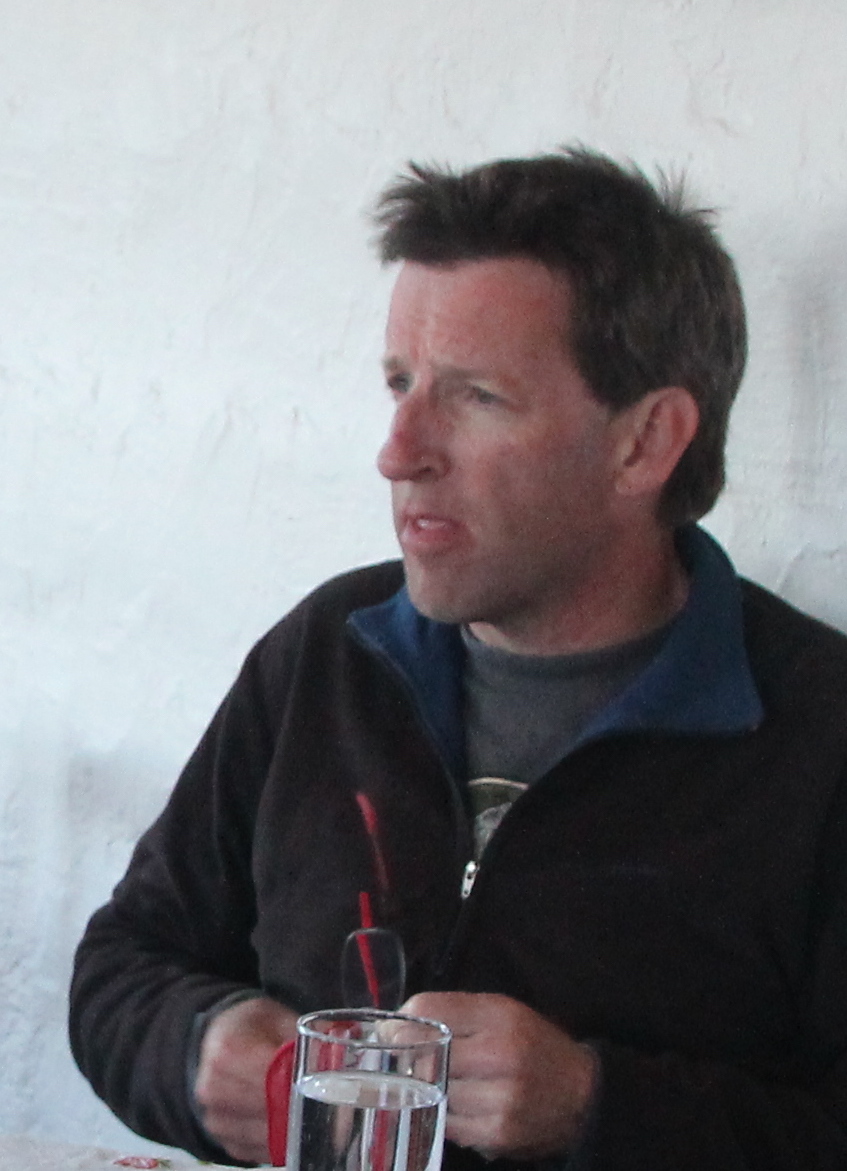 The dark-eyed juncos have moved in in force, hopping around on the bare dirt beneath the bird feeder. They tend to have a greater fondness to feeding on the ground than the finches and chickadees and house sparrows that perch up high. Or maybe it’s just that the latter species—full-time locals—are more brash and don’t make way for the more diffident juncos. Fortunately for the juncos, most of the other birds tend to be messy eaters that scatter some of the sunflower seeds onto the ground, so that the system works for these different feeding styles.
The dark-eyed juncos have moved in in force, hopping around on the bare dirt beneath the bird feeder. They tend to have a greater fondness to feeding on the ground than the finches and chickadees and house sparrows that perch up high. Or maybe it’s just that the latter species—full-time locals—are more brash and don’t make way for the more diffident juncos. Fortunately for the juncos, most of the other birds tend to be messy eaters that scatter some of the sunflower seeds onto the ground, so that the system works for these different feeding styles.
It’s a bit odd to write that the juncos have moved in because these little songbirds can be found here year-round, but it’s primarily different juncos that live here in summer and winter. Dark-eyed juncos are sort of a portmanteau species, a highly diverse grouping of multiple subspecies and different plumages that ornithologists have decided are all closely related even though there is wide variation in what they look like. In the Sibley field guide the descriptions take up a full two-and-a-half pages:
Appearance: small, slender, cleanly marked sparrows with striking white outer tail feathers.
Habitat: nest in coniferous woods and in winter flock together in open woods and brushy clearings.
Northern Arizona’s winter juncos are mostly of the dark-hooded variety that nest farther north, in the forests of the Pacific Northwest and British Columbia, or the pink-sided variety that comes to us from Wyoming and Montana. Our summer juncos are a relatively pale red-backed variety with a sporty black bandit mask and a cinnamon mantle across the back. In winter, these birds tend to migrate south to southern Arizona and Mexico. What they share in this diversity is a buzzy song, those flashy tail feathers that probably serve to startle predators when the need arises and a good tolerance for cold.
In other words: lots of surface diversity that overlays a common core of body type and behavior. In other words: they’re a lot like people. In fact, across much of the country juncos have often been called “snowbirds” because of the way they show up only in the cold months, fleeing the harsher conditions farther north. In this they’re a model for the dispersed groupings of older Minnesotans and British Columbians that congregate in mild Arizona habitats in winter. Their field guide description might read:
Appearance: generally pale-skinned; dress casual but tidy; often found in golf clothing.
Habitat: desert basins, esp. near water or human habitations; fairly social, tending to congregate with others of the same kind; form dense agglomerations along the lower Colorado River and around Quartzsite, Arizona.
Behavior: generally quiet even when seen in groups; often in pairs, but no visible evidence of breeding behavior in winter habitat.
With the exception of the rolled eyes or quiet curses that ensue when these migrants briefly screw up traffic with their giant RVs, they tend to be eagerly awaited in their winter habitats; after all, they are quiet and well-mannered and bring not only their own shelters but ready spending money with them.
That both the avian snowbirds and the human ones can share the same name—not just snowbirds, but also migrants—underscores how, along with their existence in the actual world, migrants also exist on a cultural plane, on a spectrum that extends from the humorous to the profound. Dip into the genre so generically called nature writing, and you’ll find that it’s rife with deep spiritual experience fueled by encounters with migratory birds, or other animals, whose appearance is like the ticking of a great world clock. (Mea culpa: I have written some of those essays.) Becoming aware of them is like becoming attuned to the Earth’s great ongoing mindfulness exercise, a reminder that there are large-scale patterns going on out there—beyond human reach—in which many of us find comfort and meaning.
It has been jarring then to read of late of a very different usage of the word migrant. I’m sure you know who I mean, though the nature of much of the discourse in our media might lead to the conclusion that—as with birds—what is a more readily reached-for pronoun than who. I mean:
Appearance: generally brown-skinned; dark-haired; dress casual, often colorful, but travel-stained.
Habitat: in migration, found along roads in Mexico; farther north, dispersed and often out of sight in rural areas, or in urban areas little visited by outside observers.
Behavior: travel in family groups, and often in larger clusters.
A further description of behavior is difficult for a single author to write because our overall conception of what, or who, these migrants are is so contested. So, depending on whether you gravitate toward the conservative field guide, or the more liberal one:
1: highly invasive; typically continue moving northward until they have overwhelmed existing communities through crime, economic competition or high rates of reproduction.
2: typically continue moving northward until they have found economic opportunity and safe conditions for raising their children.
What I have found weird is less this political split in perception than the odd fact that we are using the same word to describe two fundamentally different types of movement, namely the repeated and predictable seasonal movements of the snowbirds, and the one-time movements of the refugees. As a perfectionist, I don’t like that. But the Oxford English Dictionary tells me that this is OK, that the word does in fact cover both these definitions, with the verb migrate meaning both “pass regularly between habitats according to the seasons” and “move from one country or place of residence to settle in another.” As a writer I do like that, ambiguity being a valuable tool for literature, if not always for agreed-upon shared meaning.
Words are like species, forever changing and morphing and subject to debate about what exactly is included and what isn’t. Those debates can be almost as contentious as those about nations—who’s in, who’s out? What is a nation, anyway? A precise list of members, or an idea about how to govern ourselves and make lives in a shared space?
It is obvious there are no easy answers to these questions these days, or at least no answers that are widely shared across our political divide, or divides. But the lively experience of watching the migrants at the birdfeeder does prompt another question, one that to me at least is easy to answer. In southern Arizona, it’s perfectly legal to feed birds, but Samaritans who make water available to human migrants coming north are charged with a crime.
The question is: is that right?

